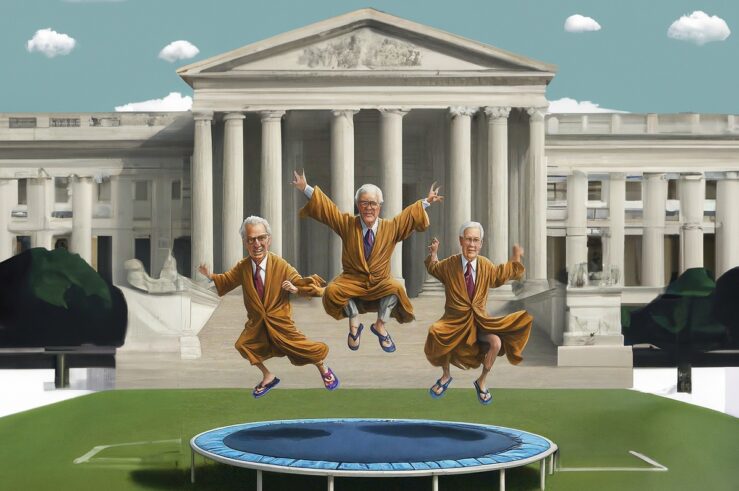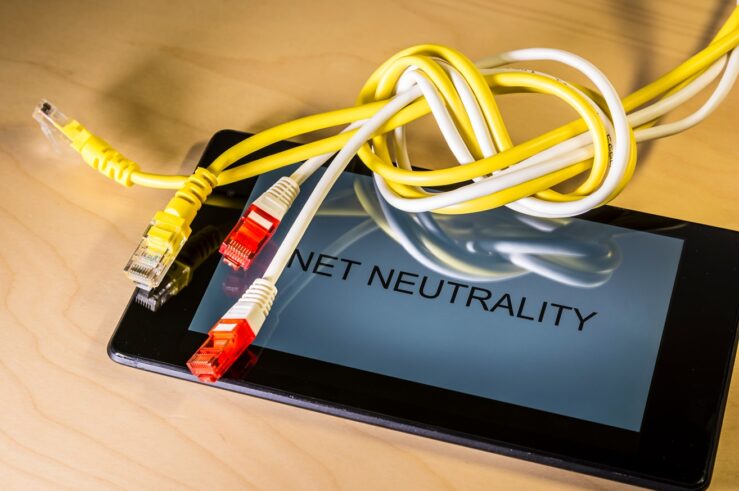Showing archive for: “Net Neutrality”
Will the Courts Allow the FCC to Execute One More Title II Flip Flop?
The U.S. Supreme Court’s recent decision in Loper Bright v. Raimondo may have added a new wrinkle to the decades-long fight over whether broadband internet-access services should be classified as “telecommunications services” under Title II of the Communications Act. The Federal Communications Commission (FCC) has flip-flopped multiple times over the years on this hotly debated ... Will the Courts Allow the FCC to Execute One More Title II Flip Flop?
Net Neutrality and the Paradox of Private Censorship
With yet another net-neutrality order set to take effect (the link is to the draft version circulated before today’s Federal Communications Commission vote; the final version is expected to be published in a few weeks) and to impose common-carriage requirements on broadband internet-access service (BIAS) providers, it is worth considering how the question of whether ... Net Neutrality and the Paradox of Private Censorship
Clearing the Telecom Logjam: A Modest Proposal
In this “Age of the Administrative State,” federal agencies have incredible latitude to impose policies without much direction or input from Congress. President Barack Obama fully pulled off the mask in 2014, when he announced “[w]e are not just going to be waiting for legislation,” declaring “I’ve got a pen, and I’ve got a phone.” ... Clearing the Telecom Logjam: A Modest Proposal
Section 214: Title II’s Trojan Horse
The Federal Communications Commission (FCC) has proposed classifying broadband internet-access service as a common carrier “telecommunications service” under Title II of the Communications Act. One major consequence of this reclassification would be subjecting broadband providers to Section 214 regulations that govern the provision, acquisition, and discontinuation of communication “lines.” In the Trojan War, the Greeks ... Section 214: Title II’s Trojan Horse
A Holiday Hootenanny Hiatus, But First, Some Title II Talk
For those of who’ve been doing the Telecom Two-Step over the past year, the holiday break can’t come soon enough. Last week, comments were due on the Federal Communications Commission’s (FCC) latest proposal to impose Title II common-carrier regulation under the guise of net neutrality national security. Before that, we had the FCC’s new and ... A Holiday Hootenanny Hiatus, But First, Some Title II Talk
Has the Biden Administration Taken Over Broadband?
Betteridge’s Law of Headlines states: “Any headline that ends in a question mark can be answered by the word no.” But, apparently, folks in the nation’s capital found a way around Betteridge’s Law. This week, a U.S. House subcommittee hearing featured testimony from all five members of the Federal Communications Commission (FCC). The majority on ... Has the Biden Administration Taken Over Broadband?
An Inconvenient Truth: Net Neutrality Depresses Broadband Investment
It happens at just about every hootenanny. There’s always at least one song that clears the dance floor. Some tunes, people just won’t dance to. But with a little remixing and a better tempo, even a dirge can be danceable. For years, the Federal Communications Commission (FCC) has refused to dance to the tune of ... An Inconvenient Truth: Net Neutrality Depresses Broadband Investment
Net Neutrality and Broken Records
I don’t mean to sound like a broken record, but why is the Federal Communications Commission (FCC) playing a broken record? I’ve been writing a fair bit about Federal Trade Commission (FTC) rulemaking initiatives. On the theory that you deserve a nominal break from all of that, this post is mostly about the FCC. On ... Net Neutrality and Broken Records
All Aboard! The Title II Express Is Leaving the Station
At lunch last week, I handed out the first of my new business cards with the title “Director, Hootenanny Division.” My lunchmate looked down and said, “Sounds fun, what do you do?” Then, I had to explain that part of the job involves watching open meetings of the Federal Communications Commission (FCC) and reporting on ... All Aboard! The Title II Express Is Leaving the Station
How ETNO’s ‘Fair Share’ Proposal Threatens Europe’s Digital Future:
The digital transformation of Europe—and, indeed, the world—has been a defining theme of the 21st century. As with all significant shifts, it has also come with its share of challenges, opportunities, and controversies. One such controversy that has recently reemerged is the so-called “fair share” proposal for network traffic—championed most recently in a statement from ... How ETNO’s ‘Fair Share’ Proposal Threatens Europe’s Digital Future:
Net Neutrality Is Dead, Long Live National Security
Federal Communications Commission (FCC) Chair Jessica Rosenworcel announced plans last week for the commission to vote Oct. 19 on whether to take the first steps toward reinstating Title II regulations on broadband providers. Two days later, the FCC issued a notice of proposed rulemaking (NPRM) for the Safeguarding and Securing the Open Internet (SSOI) order. ... Net Neutrality Is Dead, Long Live National Security
Net Neutrality II: Electric Boogaloo—Rate Regulation Hiding in Plain Sight
Federal Communications Commission (FCC) Chair Jessica Rosenworcel on Tuesday announced the agency’s proposal to regulate internet services under Title II of the Communications Act. Commonly referred to as “net neutrality,” the chair plans to release proposed rules today, with a vote scheduled for Oct. 19 to begin the rulemaking process. Rosenworcel’s speech identified several areas ... Net Neutrality II: Electric Boogaloo—Rate Regulation Hiding in Plain Sight
















